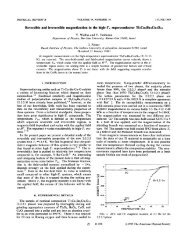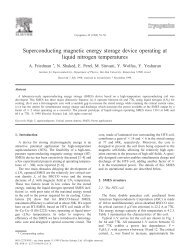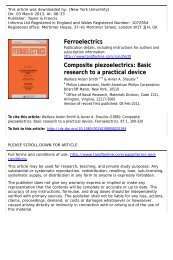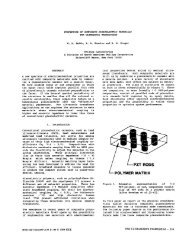Sonochemical synthesis of nanocrystalline LaFeO 3 - ResearchGate
Sonochemical synthesis of nanocrystalline LaFeO 3 - ResearchGate
Sonochemical synthesis of nanocrystalline LaFeO 3 - ResearchGate
Create successful ePaper yourself
Turn your PDF publications into a flip-book with our unique Google optimized e-Paper software.
Fig. 2 Powder X-Ray diffraction patterns <strong>of</strong> (a) amorphous Fe 2 O 3 ,<br />
(b) amorphous Fe 2 O 3 dispersed on La 2 O(CO 3 ) 2 ?1.4?H 2 Oand(c)<strong>LaFeO</strong> 3<br />
obtained by calcining the precursor at 800 uC in air for 24 h.<br />
resultant product obtained during this process. It can be seen<br />
from this pattern that the Fe 2 O 3 obtained in this process is<br />
amorphous. The absence <strong>of</strong> this amorphous background due to<br />
Fe 2 O 3 in Fig. 2(b) may be due to the dominance <strong>of</strong> crystalline<br />
La 2 O(CO 3 ) 2 ?1.4?H 2 O peaks. Fig. 2(c) shows the XRD pattern<br />
<strong>of</strong> <strong>LaFeO</strong> 3 obtained by calcining the precursor sample at 800 uC<br />
in air atmosphere for 24 h. The diffraction peaks match those<br />
reported for standard <strong>LaFeO</strong> 3 (JCPDS file No. 37-1493).<br />
Heating the precursor at a rate <strong>of</strong> 8 uC min 21 to 800 uC resulted<br />
in a well-crystallized ferrite phase. This was indicated by the<br />
appearance <strong>of</strong> the most intense reflections: (121), (202) and<br />
(240) peaks at 2h values <strong>of</strong> 38.28, 54.78 and 68.43u, respectively,<br />
as shown in Fig. 2(c). Thus, the formation <strong>of</strong> <strong>LaFeO</strong> 3 is<br />
completed at 800 uC. The formation temperature for <strong>LaFeO</strong> 3<br />
by the sonochemically prepared precursor is clearly lower than<br />
that observed in the conventional solid-state reaction utilizing<br />
La 2 O(CO 3 ) 2 ?1.4?H 2 O and Fe 2 O 3 (y1000 uC for 184 h) for<br />
forming a single phase <strong>of</strong> <strong>LaFeO</strong> 24 3 . Thus, the formation<br />
temperature <strong>of</strong> <strong>LaFeO</strong> 3 by this process compares reasonably<br />
well with many other chemistry based processing routes.<br />
(C) IR<br />
The IR spectra <strong>of</strong> the amorphous iron oxide coated on lanthanum<br />
carbonate, amorphous iron oxide (for comparison) and<br />
calcined <strong>nanocrystalline</strong> <strong>LaFeO</strong> 3 powder in the wavenumber<br />
range from 3000 to 400 cm 21 are shown in Fig. 3(a)–(c). The IR<br />
spectrum <strong>of</strong> Fig. 3(b) provides evidence for the presence <strong>of</strong><br />
carbonate ions <strong>of</strong> La 2 O(CO 3 ) 2 ?1.4H 2 O in the precursor; it also<br />
shows a broad band at ca. 1400cm 21 , which is assigned to the<br />
bending vibrational mode <strong>of</strong> bound water molecules. 18 The<br />
absorption band at ca.1481cm 21 is attributed to the n 3 mode <strong>of</strong><br />
the CO 22 3 ion while the other bands at ca. 1071, 850 and 725 cm 21<br />
have been assigned to the n 1 , n 2 and n 4 modes <strong>of</strong> the carbonate<br />
ions, respectively. 18 The above observed bands clearly indicate the<br />
presence <strong>of</strong> carbonate ions in the precursor. However, this<br />
spectrum does not show the peaks for amorphous Fe 2 O 3 which<br />
might be due to the relatively high intensity peaks <strong>of</strong> lanthanum<br />
carbonate. The IR spectrum <strong>of</strong> the amorphous Fe 2 O 3 synthesized<br />
by ultrasound alone (for comparison) shows absorption bands at<br />
473, 1424 and 1550 cm 21 (Fig. 3(a)). Also, the peaks observed at<br />
1424 and 1550 cm 21 support the presence <strong>of</strong> oxalate ion.<br />
In addition, the peak centered at 473 cm 21 indicates the presence<br />
<strong>of</strong> amorphous iron oxide. 25 Fig. 3(c) shows the IR spectrum <strong>of</strong><br />
<strong>LaFeO</strong> 3 . This spectrum shows well-established strong absorption<br />
bands at y570 and y430 cm 21 in the powder calcined at<br />
Fig. 3 IR spectra <strong>of</strong> (a) amorphous Fe 2 O 3 , (b) amorphous Fe 2 O 3<br />
dispersed on La 2 O(CO 3 ) 2 ?1.4H 2 O and (c) <strong>LaFeO</strong> 3 obtained by<br />
calcining the precursor at 800 uC in air for 24 h.<br />
800 uC indicating the formation <strong>of</strong> lanthanum ferrite. The<br />
570 cm 21 band is attributed to the Fe–O stretching vibration<br />
(n 1 mode), and the 430 cm 21 band corresponds to the O–Fe–O<br />
deformation vibration (n 2 mode). 26 Comparing, Fig. 3(c) with<br />
Fig. 3(a) and (b), we can see after calcination that the<br />
characteristic bands <strong>of</strong> La 2 O- (CO 3 ) 2 ?1.4H 2 O and iron oxide<br />
vanish at this calcination temperature and only Fe–O stretching<br />
vibration bands are found in the <strong>synthesis</strong>ed powder. The above<br />
interpretation <strong>of</strong> the IR spectral results is based on the assumption<br />
that the synthesized carbonate, Fe 2 O 3 , precursor, and lanthanum<br />
ferrite are essentially pure materials. These results agree with the<br />
XRD phase-analysis findings.<br />
(D) EDAX<br />
Elemental analysis using EDAX indicates that the product <strong>of</strong><br />
calcination obtained from the precursor has a La:Fe ratio <strong>of</strong><br />
1:1 (within the range 0.98–1.01) indicating the equal presence<br />
<strong>of</strong> La and Fe in the sample. Also, a similar analysis for the<br />
amorphous Fe 2 O 3 obtained from Fe(CO) 5 shows the presence<br />
<strong>of</strong> Fe and O in a ratio ranging from 1:1.5 to 1:2. The higher<br />
ratio is due to the strong adsorption <strong>of</strong> oxygen as has been<br />
reported by Cao et al. 23 No other elements were detected in the<br />
EDAX <strong>of</strong> the amorphous compound.<br />
(E) Mössbauer studies<br />
As confirmation <strong>of</strong> the phase purity <strong>of</strong> the prepared samples,<br />
Fig. 4 shows the 57 Fe Mössbauer spectrum measured at 27 uC<br />
Fig. 4 Mössbauer spectrum <strong>of</strong> the <strong>LaFeO</strong> 3 sample obtained by<br />
calcining the precursor at 800 uC in air for 24 h.<br />
766 J. Mater. Chem., 2004, 14, 764–769








